About Shaft Couplings
More
About Shaft Collars
Shaft collars are useful for holding and positioning components on a shaft. They can also serve as mechanical stops and stroke limiters.
More
Set Screw Flexible Shaft Couplings
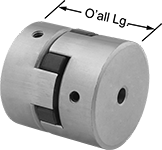
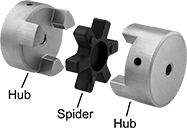


Each hub includes a set screw (unless noted), which bites into your shaft to hold the coupling in place. Also known as Lovejoy® couplings, these three-piece couplings have a spider-shaped cushion between two hubs to reduce shock and handle minor shaft misalignment.
A complete coupling consists of two hubs and one spider, or two hubs, one split spider, and one retaining ring (all components sold separately). Split spiders are easier to install and replace than standard spiders because there’s no need for tools or removing your hubs. Twist-lock them in place using a retaining ring.
Buna-N spiders provide good vibration damping and chemical resistance. Hytrel spiders provide fair vibration damping and excellent chemical resistance. Polyurethane spiders and split spiders provide fair vibration damping and good chemical resistance.
For technical drawings and 3-D models, click on a part number.
Buna-N Rubber Spiders | |||||||||||||
|---|---|---|---|---|---|---|---|---|---|---|---|---|---|
Iron Hubs | Misalignment Capability | ||||||||||||
| Overall Lg. | OD | For Shaft Type | For Motion Type | For Shaft Dia. | Each | Max. Speed, rpm | Max. Torque, in.-lbs. | Parallel | Angular | Temp. Range, °F | Each | ||
| 4 7/32" | 3 21/64" | Keyed | Forward/Reverse, Start/Stop | 38mm | 0000000 | 000000 | 5,000 | 790 | 0.015" | 1° | -40° to 212° | 0000000 | 000000 |
| 4 1/2" | 3 3/4" | Keyed | Forward/Reverse, Start/Stop | 38mm | 0000000 | 000000 | 5,000 | 1,240 | 0.015" | 1° | -40° to 212° | 0000000 | 00000 |
Buna-N Rubber Spiders | |||||||||||||
|---|---|---|---|---|---|---|---|---|---|---|---|---|---|
Steel Hubs | Misalignment Capability | ||||||||||||
| Overall Lg., mm | OD, mm | For Shaft Type | For Motion Type | For Shaft Dia., mm | Each | Max. Speed, rpm | Max. Torque, in.-lbs. | Parallel | Angular | Temp. Range, °F | Each | ||
| 124 | 115 | Keyed | Forward/Reverse, Start/Stop | 38 | 0000000 | 0000000 | 5,000 | 1,725 | 0.015" | 1° | -40° to 212° | 0000000 | 000000 |
| 137 | 127 | Keyed | Forward/Reverse, Start/Stop | 38 | 0000000 | 000000 | 4,200 | 2,340 | 0.015" | 1° | -40° to 212° | 0000000 | 00000 |
Hytrel Rubber Spiders | |||||||||||||
|---|---|---|---|---|---|---|---|---|---|---|---|---|---|
Iron Hubs | Misalignment Capability | ||||||||||||
| Overall Lg. | OD | For Shaft Type | For Motion Type | For Shaft Dia. | Each | Max. Speed, rpm | Max. Torque, in.-lbs. | Parallel | Angular | Temp. Range, °F | Each | ||
| 4 7/32" | 3 21/64" | Keyed | Forward/Reverse, Start/Stop | 38mm | 0000000 | 000000 | 3,600 | 2,265 | 0.015" | 0.5° | -55° to 245° | 0000000 | 0000000 |
| 4 1/2" | 3 3/4" | Keyed | Forward/Reverse, Start/Stop | 38mm | 0000000 | 000000 | 3,600 | 3,705 | 0.015" | 0.5° | -55° to 245° | 0000000 | 000000 |
Hytrel Rubber Spiders | |||||||||||||
|---|---|---|---|---|---|---|---|---|---|---|---|---|---|
Steel Hubs | Misalignment Capability | ||||||||||||
| Overall Lg., mm | OD, mm | For Shaft Type | For Motion Type | For Shaft Dia., mm | Each | Max. Speed, rpm | Max. Torque, in.-lbs. | Parallel | Angular | Temp. Range, °F | Each | ||
| 124 | 115 | Keyed | Forward/Reverse, Start/Stop | 38 | 0000000 | 0000000 | 5,000 | 4,680 | 0.015" | 0.5° | -55° to 245° | 0000000 | 0000000 |
| 137 | 127 | Keyed | Forward/Reverse, Start/Stop | 38 | 0000000 | 000000 | 4,200 | 6,225 | 0.015" | 0.5° | -55° to 245° | 0000000 | 000000 |
Polyurethane Spiders | |||||||||||||
|---|---|---|---|---|---|---|---|---|---|---|---|---|---|
Iron Hubs | Misalignment Capability | ||||||||||||
| Overall Lg. | OD | For Shaft Type | For Motion Type | For Shaft Dia. | Each | Max. Speed, rpm | Max. Torque, in.-lbs. | Parallel | Angular | Temp. Range, °F | Each | ||
| 4 7/32" | 3 21/64" | Keyed | Forward/Reverse, Start/Stop | 38mm | 0000000 | 000000 | 3,600 | 1,185 | 0.015" | 1° | -30° to 160° | 0000000 | 0000000 |
| 4 1/2" | 3 3/4" | Keyed | Forward/Reverse, Start/Stop | 38mm | 0000000 | 000000 | 3,600 | 1,860 | 0.015" | 1° | -30° to 160° | 0000000 | 000000 |
Polyurethane Split Spiders | |||||||||||||||
|---|---|---|---|---|---|---|---|---|---|---|---|---|---|---|---|
Iron Hubs | Misalignment Capability | 347 Stainless Steel Retaining Rings | |||||||||||||
| Overall Lg. | OD | For Shaft Type | For Motion Type | For Shaft Dia. | Each | Max. Speed, rpm | Max. Torque, in.-lbs. | Parallel | Angular | Temp. Range, °F | Each | Each | |||
| 4 7/32" | 3 21/64" | Keyed | Forward/Reverse, Start/Stop | 38mm | 0000000 | 000000 | 5,900 | 2,180 | 0.03" | 2° | -30° to 200° | 0000000 | 0000000 | 0000000 | 0000000 |
High-Torque Set Screw Flexible Shaft Couplings
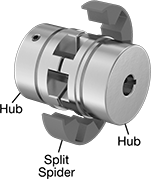
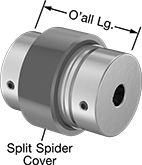
The thick split spider on these couplings takes on twice as much torque as standard split spiders, while a set screw holds the hubs in place on your shaft. Also known as jaw couplings, use them to connect motors to pumps, mixers, and other high-torque equipment. You don’t need to lubricate them.
For a complete coupling, you’ll need two hubs, one split spider, and a split spider cover (all sold separately).
Hubs attach to the end of your shaft.
Split spiders cushion between the two hubs to dampen vibration, reduce shocks, and handle shaft misalignment, extending the life of bearings, seals, and motors. You can replace them without having to remove the hubs or move your shaft and equipment around, which reduces the risk of needing to realign the shaft. Spiders with medium-soft hardness are the most commonly used and are good for applications that start, stop, and reverse often. Those with medium hardness handle higher torque than those with medium-soft hardness, but they don’t reduce vibration as well.
Split spider covers hold the spider in place.
For technical drawings and 3-D models, click on a part number.
Urethane Split Spiders | |||||||||||||||
|---|---|---|---|---|---|---|---|---|---|---|---|---|---|---|---|
Steel Hubs | Misalignment Capability | Steel Split Spider Covers | |||||||||||||
| Overall Lg. | OD | For Motion Type | For Shaft Dia. | Each | Max. Speed, rpm | Max. Torque, in.-lbs. | Parallel | Angular | Temp. Range, °F | Color | Each | Each | |||
| 4 29/32" | 3 3/16" | Forward/Reverse, Start/Stop | 38mm | 000000 | 0000000 | 7,000 | 3,425 | 0.039" | 2° | -60° to 212° | Red | 0000000 | 000000 | 0000000 | 000000 |
Urethane Split Spiders | |||||||||||||||
|---|---|---|---|---|---|---|---|---|---|---|---|---|---|---|---|
Steel Hubs | Misalignment Capability | Steel Split Spider Covers | |||||||||||||
| Overall Lg. | OD | For Motion Type | For Shaft Dia. | Each | Max. Speed, rpm | Max. Torque, in.-lbs. | Parallel | Angular | Temp. Range, °F | Color | Each | Each | |||
| 4 29/32" | 3 3/16" | Forward/Reverse, Start/Stop | 38mm | 000000 | 0000000 | 7,000 | 6,460 | 0.039" | 2° | -60° to 212° | Blue | 0000000 | 000000 | 0000000 | 000000 |
Urethane Split Spiders | |||||||||||||||
|---|---|---|---|---|---|---|---|---|---|---|---|---|---|---|---|
Steel Hubs | Misalignment Capability | Steel Split Spider Covers | |||||||||||||
| Overall Lg. | OD | For Motion Type | For Shaft Dia. | Each | Max. Speed, rpm | Max. Torque, in.-lbs. | Parallel | Angular | Temp. Range, °F | Color | Each | Each | |||
| 4 29/32" | 3 3/16" | Forward/Reverse, Start/Stop | 38mm | 000000 | 0000000 | 7,000 | 6,460 | 0.039" | 2° | -60° to 350° | White | 0000000 | 0000000 | 0000000 | 000000 |
High-Speed Vibration-Damping Flexible Shaft Couplings
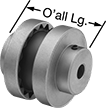
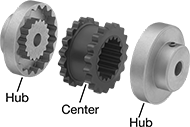
Use these gear-shaped couplings for high-speed and high-torque applications. A rubber center allows flexing so couplings can take on multiple types of misalignment while damping vibration and shock. With no metal-to-metal contact, there’s no need for lubrication. Fasten to your shafts by tightening the set screws, which bite into the shaft to hold it.
A complete coupling consists of two hubs and one center (each component sold separately).
Hubs have a keyway, except hubs for 1/4" and 3/8" shaft dia. do not have a keyway.
For technical drawings and 3-D models, click on a part number.
Centers | |||||||||||||||
|---|---|---|---|---|---|---|---|---|---|---|---|---|---|---|---|
Hubs | Misalignment Capability | ||||||||||||||
| O'all Lg. | OD | For Motion Type | Material | For Shaft Dia. | Each | Max. Speed, rpm | Max. Torque, in.-lbs. | Parallel | Angular | Axial | Temp. Range, °F | Material | Each | ||
| 3 15/16" | 4 5/8" | Continuous | Cast Iron | 38mm | 000000 | 000000 | 5,250 | 725 | 0.02" | 1° | 0.125" | -30° to 275° | TPE Rubber | 0000000 | 000000 |
| 4 7/16" | 5 29/64" | Continuous | Cast Iron | 38mm | 0000000 | 00000 | 4,500 | 1,135 | 0.02" | 1° | 0.125" | -30° to 275° | TPE Rubber | 0000000 | 00000 |
Clamping Shaft Collars

These metal collars are stronger than plastic shaft collars. They clamp evenly around the shaft to create a strong, mar-free hold. To use, slide onto your shaft and tighten the clamping screw to secure.
Black-oxide steel collars have some corrosion resistance.
For technical drawings and 3-D models, click on a part number.
Clamping Screw | ||||||
|---|---|---|---|---|---|---|
| For Shaft Dia., mm | OD, mm | Wd., mm | Type | No. Included | Each | |
Black-Oxide 1215 Carbon Steel | ||||||
| 38 | 60 | 15 | Socket Head Screw | 1 | 000000000 | 000000 |
Quick-Release Clamping Shaft Collars
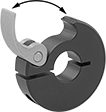
Installing and removing a collar is as easy as pushing down and lifting up a clamp lever. Collars clamp evenly around the shaft to create a strong, mar-free hold. All have a clamping screw to adjust lever tension. Made of anodized aluminum, they are lightweight with good corrosion resistance.
For technical drawings and 3-D models, click on a part number.
Clamping Screw | Black Anodized 6061 Aluminum | |||||
|---|---|---|---|---|---|---|
| For Shaft Dia. | OD | Wd. | Type | No. Included | Each | |
| 38mm | 75mm | 15mm | Socket Head Screw | 1 | 00000000 | 000000 |
Tight-Hold Quick-Release Clamping Shaft Collars

A threaded lever lets you tighten these collars with more torque than other quick-release styles, ensuring that they stay put on your shaft. Use them to quickly move components or make setup changes, such as on packing equipment, printers, or label feeding machines. To make adjustments in tight spaces, lift the lever and twist to the side. Similar to a ratchet, you can lift the lever to disengage from the threads and reposition.
Black oxide steel collars are very strong, but will rust if exposed to moisture.
Anodized aluminum is strong and lightweight. It can withstand humidity without rusting, but water left on the surface will cause it to corrode.
303 stainless steel collars can handle frequent exposure to water without rusting.
For technical drawings and 3-D models, click on a part number.
Set Screw Shaft Collars

Keep these shaft collars in place by tightening their set screw into the shaft. The tip of the screw digs in for a secure hold, but will mar the shaft’s surface. For maximum holding power, make sure the set screw material is harder than your shaft material. Use these shaft collars to position and retain power transmission components such as sprockets, pulleys, and bearings. You can also use them to limit the movement of a shaft.
Carbon steel collars are strong and wear resistant. Collars that are blue make it easy to identify metric collars at a glance. They’re tinted to match other blue metric fasteners.
303 stainless steel collars are corrosion resistant and highly machinable.
DIN 705 collars meet an international standard for shaft collar dimensions.
For technical drawings and 3-D models, click on a part number.
Clamping Two-Piece Shaft Collars

These metal collars are stronger than plastic shaft collars. The two-piece design allows you to install them anywhere on a shaft without removing components or having access to the ends of the shaft. Collars clamp evenly around the shaft to create a strong, mar-free hold. Tighten the clamping screws to secure.
Black-oxide steel collars have some corrosion resistance. Zinc-plated steel and chrome-plated steel collars have moderate corrosion resistance with a bright finish. Aluminum collars are lightweight and have good corrosion resistance. 303 stainless steel collars have excellent corrosion resistance.
For technical drawings and 3-D models, click on a part number.
Quick-Release Two-Piece Clamping Shaft Collars

Make quick adjustments to these shaft collars with a lever on the side. Often used on packing equipment, printers, and label feeding machines, these collars are used to quickly move components or make setup changes. To make adjustments in tight spaces, lift the lever and twist to either side. Similar to a ratchet, you can tighten and loosen with the lever down; lift the lever to disengage from the threads and reposition. The two pieces of the collar separate, so you can install them anywhere on a shaft without removing components or having access to the end.
Black oxide steel collars are very strong, but will rust if exposed to moisture.
Anodized aluminum is strong and lightweight. It can withstand humidity without rusting, but water left on the surface will cause it to corrode.
303 stainless steel collars can handle frequent exposure to water without rusting.
For technical drawings and 3-D models, click on a part number.

























